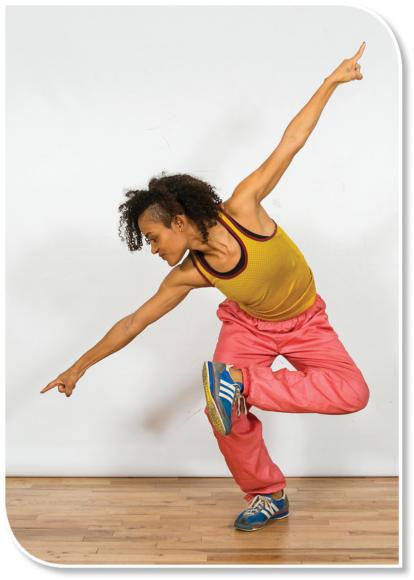The vestibular system’s effectiveness is heightened by ways in which it interacts with other senses, especially vision. One example is the vestibular ocular reflex (VOR), which stabilizes the eyes during head movement. This reflex is especially important during very fast movements of the head, such as dancers’ use of spotting when doing multiple turns. Dancers must rely heavily on vision when they are learning dance forms that mainly use turns with the torso and the head upright. The dancers are taught strategies such as spotting to preserve spatial orientation and balance. However, modern dance and street dance turn with the torso off the vertical, and vision can actually hinder the skill. When turning with the torso off the vertical, what dancers see can be confusing because it is misaligned relative to normal vision. It can be disorienting to see the environment in upside-down positions, so dancers must rely more heavily on somatosensory feedback than vision during these movements. In the dance class setting, it is crucial that the teacher first determine that the students are secure in the off-vertical position before they attempt to turn in it. Then dancers can attempt turning, and finally they can achieve turning with simultaneous locomotion. Integrating postural control into locomotion while reducing assistance from vision can be a frightening experience. It is a mistake to introduce turning with the torso off the vertical too soon, because it can foster a fear of falling.

In street dance, the head and torso are often in a different orientation to gravity than typical walking, and the dancers must rely more on somatosensory feedback than on vision.
In most situations that dancers encounter, if visual and somatosensory information are in conflict, the vestibular system takes precedence and resolves the conflict. Consider a street dancer outside at night with limited vision and dealing with constantly changing terrain. At this point visual information would be limited and somatosensory information from the ankles would be unpredictable. The dancer would be dependent on the vestibular system for maintaining balance. The same situation would occur with a dancer in dark lighting on a raked stage.
The vestibular system of the dancer should be conditioned to many peculiar relationships to gravity. It is not uncommon for a much-practiced, automatic balance to fall apart when a dancer is lifted, placed in an upside-down position, and then returned to the ground. It becomes even more disorienting when the lifter spins with the partner in the air. Dancers (both the one doing the lifting and the one being lifted) should not attempt this task at full speed and with multiple turns until they are experienced. The more accustomed a dancer becomes to being lifted off the ground and turned upside down, the better the brain becomes at interpreting the spatial information provided by the vestibular system.
While vision is clearly the predominant sense in terms of the body’s relationship to the environment, the vestibular system plays an important role in balance, posture, and dynamic motion through space. Its role in maintaining a clear relationship to gravity at all times is essential in the dancer’s ability to do complex and often disorienting movement. Given the addition of many circumstances in which dancers must work in low or no lighting and on unusual surfaces, the vestibular system is the dependable partner to the visual system.
Save
Save